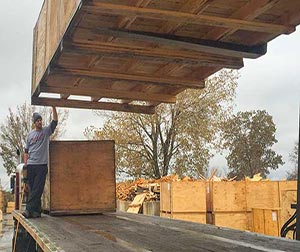LTL – LESS THAN TRUCK LOAD SERVICES

Less-Than-Truckload (LTL) has a reputation for being an expensive and slow shipping option, but it’s a mode that provides a lot of flexibility for shippers when used correctly. Since LTL shipments are moved with multiple other orders, pricing is partially based on how much space the freight takes up. It’s imperative that proper dimensions are provided on a bill of lading. An LTL quote is based off product density and commodity type. So, when the shipment dimensions provided are inaccurate, so is quoted pricing.
Each commodity also has its own “Freight Class” to determine pricing. Freight Classification is a National Motor Freight Classification (NMFC) standard used to classify and rate commodities (items you are shipping) primarily based on their density and value. Each commodity is categorized into one of 18 classes – lowest being class 50 and highest being class 500 – based on four transportation characteristics: density, stow ability, handling, and liability.
Click here for a quote
HOW TO EVALUATE YOUR FREIGHT
Each type of freight is evaluated on density, handling, liability, and stow ability.
- Density: Pounds per cubic feet. Typically, high density equates to lower freight class, and vice versa.
Freight density is calculated as follows:
- Step 1. Measure the height, width, and depth of the shipment in inches. Measure to the farthest points, including skids or other packaging. On shipments with multiple pieces, repeat Step 1 for each piece.
- Step 2. Multiply the three measurements (height x width x depth). The result is the total cubic inches of the shipment. If you have multiple pieces, multiply the height x width x depth for each piece. Take the results for each piece and add them together to get the total cubic inches
- Step 3. Divide the total cubic inches by 1,728 (the number of cubic inches in a cubic foot). The result is the cubic feet of the shipment.
- Step 4. Divide the weight (in pounds) of the shipment by the total cubic feet. The result is the pounds per cubic foot.
- Handling: The ease of moving a product between LTL terminals, looking at fragility and packaging. Any freight that requires special handling could be assigned a higher class.
- Liability: Ability to be damaged, ability to damage adjacent freight, perishability. More liability equates to a higher freight class.
- Stow ability: Can the freight be stacked or turned to maximize space, or do its dimensions or nature require it to be shipped separately? Pallets that are more difficult to store will be given a higher freight class.
LTL can ship on dry van, reefer, or flatbed equipment.
- General Commodities
- Same day service
- Overnight service
- Large, Partials and half truck load
- Dedicated service

